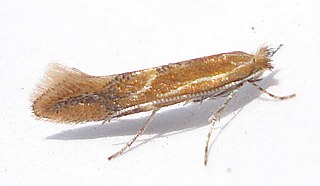
Johann Karl Ludwig Martin was a German geologist. He was professor in geology at Leiden University from 1877 to 1922. From 1880 to 1922 he also was director of the Geological Museum of Leiden. As a scientist he is known for his paleontological and stratigraphical research on the Cenozoic fauna of the Dutch East Indies, especially on mollusks.

Polyptychus affinis is a moth of the family Sphingidae first described by Walter Rothschild and Karl Jordan in 1903. It is known at elevations up to 6,000 feet (1,800 m) in forests from Sierra Leone to the Congo, Uganda and western Kenya.
Megadytes ducalis is a species of water beetle in the family Dytiscidae. With a length of 4.75 cm (1.9 in), it is the largest species in the family. Until recently, the species was only known from a single specimen that was collected in the 1800s from an unknown locality in Brazil, although rumors indicate it was found in the bottom of a canoe in the Amazon. In 2019, a study reported 10 additional specimens, all collected from the end of the 19th century, discovered incidentally in various historical collections. While the original holotype lacked any location data, the new specimens all indicate that they were collected in Santo Antonio da Barra in the southern part of Bahia, Brazil. Villagers in the region were involved in insect trade, capturing the much sought after specimens of Hypocephalus armatus found around the region. As a consequence of the lack of recent records, the IUCN lists it as extinct. Considering the absence of information about the species and the limited studies conducted on water beetles in Brazil, it might still survive.

Xanthopan is a monotypic genus of sphinx moth, with Xanthopan morganii, commonly called Morgan's sphinx moth, as its sole species. It is a very large sphinx moth from Southern Africa and Madagascar. Little is known about its biology, though the adults have been found to visit orchids and are one of the main pollinators of several of the Madagascar endemic baobab (Adansonia) species, including the critically endangered Adansonia perrieri or Perrier's baobab.
Choeropais is a monotypic moth genus in the family Noctuidae. Its only species, Choeropais jucunda, is found in Angola, the Democratic Republic of the Congo and Zaire. Both the genus and species were first described by Karl Jordan, the genus in 1913 and the species nine years earlier in 1904.
Arctiopais is a monotypic moth genus of the family Noctuidae erected by Karl Jordan in 1896. Its only species, Arctiopais ambusta, was first described by Paul Mabille in 1881. It is found on Madagascar.
Paida is a monotypic moth genus of the family Noctuidae erected by Karl Jordan in 1896. Its only species, Paida pulchra, was first described by Roland Trimen in 1863. It is found in South Africa, Namibia and Zimbabwe.

Phyllonorycter is a genus of moths in the family Gracillariidae.
Vegetia is a genus of moths in the family Saturniidae first described by Karl Jordan in 1922.
Vegetia dewitzi is a species of moth in the family Saturniidae. It was described by Peter Maassen and Gustav Weymer in 1886. It is found in South Africa.

Vegetia grimmia is a species of moth in the family Saturniidae. It was described by Carl Geyer in 1831. It is found in South Africa.
Balacra compsa is a moth of the family Erebidae. It was described by Karl Jordan in 1904. It is found in Angola, Burundi, the Democratic Republic of the Congo, Kenya, Rwanda and Uganda.

Hypena ducalis is a moth of the family Erebidae described by William Schaus and W. G. Clements in 1893. It is found in Sierra Leone.
Melisa hancocki is a moth of the family Erebidae. It was described by Karl Jordan in 1936. It is found in Uganda.
Amata chariessa is a moth of the subfamily Arctiinae. It was described by Karl Jordan in 1936. It is found in Zambia.
Utetheisa amhara is a moth in the family Erebidae. It was described by Karl Jordan in 1939. It is found in Eritrea, Ethiopia, Kenya, Saudi Arabia, Somalia and the United Arab Emirates.
Epipyrops malagassica is a moth in the family Epipyropidae. It was described by Karl Jordan in 1928. It is found on Madagascar.
Tragocephala ducalis is a species of beetle in the family Cerambycidae. It was described by White in 1856. It is known from South Africa.
Mazuca amoena is a moth in the family Noctuidae. It can be found from the Democratic Republic of the Congo to Zimbabwe, with one instance in South Africa.





